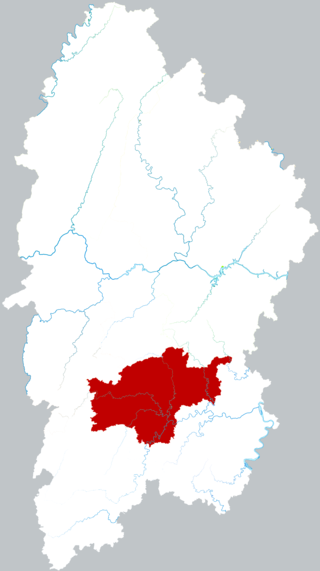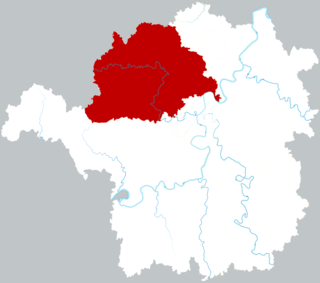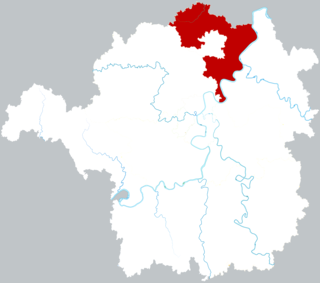
Changsha County is a county in Hunan Province, China. It is under the administration of the prefecture-level city of Changsha. Located in the west portion of Changsha, the county is bordered to the north by Miluo City and Pingjiang County, to the west by Wangcheng, Kaifu and Furong Districts, to the southwest by Yuhua District, and to the southeast and the east by Liuyang City. Changsha County covers 1,756 km2 (678 sq mi). As of 2015 it has a registered population of 743,000 and a permanent resident population of 916,000. The county has 5 subdistricts and 13 towns under its jurisdiction. The county seat is Xingsha Subdistrict (星沙街道).

Yuelu District is one of six urban districts of the prefecture-level city of Changsha, the capital of Hunan Province, China. It is the 4th most populous district in Hunan. The district is bordered to the north by Wangcheng District, to the west by Ningxiang County, to the south by Yuhu District of Xiangtan City, across the Xiang river to the west by Tianxin, Furong and Kaifu Districts. Located on the west bank of the Xiang River, as the western part of the City proper, the district is named after Mount Yuelu, one of the national parks, Yuelu District covers 538.83 km2 (208.04 sq mi) with registered population of 644,834 and resident population of 818,900. The district has 16 subdistricts and 2 towns under its jurisdiction, its administrative centre is at Wangyue (望岳街道).

Jishou is a county-level city and the seat of Xiangxi Tujia and Miao Autonomous Prefecture, Hunan province, China.

Zhongxiang is a county-level city of Jingmen, central Hubei province, People's Republic of China. The name Zhongxiang means "Blessed with propitious omen", and was given to the city by the Jiajing Emperor in the Ming dynasty.

Leiyang is a county-level city and the third most populous county-level division in Hunan Province, China. Leiyang is under the administration of the prefecture-level city of Hengyang. Located on the south of the province, the city is bordered to the north by Hengnan County, to the west by Changning City, to the south by Guiyang and Yongxing counties, to the east by Anren County. Leiyang City covers 2,656 km2 (1,025 sq mi) with registered population of 1,413,913 and resident population of 1,150,241. The city has six subdistricts, 19 towns and five townships under its jurisdiction, the government seat is Caizichi Subdistrict.

Jingning She Autonomous County is an autonomous county for the She people, under the jurisdiction of the prefecture-level city of Lishui in the south of Zhejiang Province, China.

Linquan County is a county in the northwest of Anhui Province, China, bordering Henan province to the northwest, west, and southwest. It is the westernmost county-level division of Fuyang city. The Quan River 泉河 a tributary of the Ying River flows from its source in Henan province, through the county seat in Chengguan and then along the county's northern border with Jieshou. According to the 2010 census, the population was 1,543,218, the area is 702 sq mi (1,820 km2). Linquan is the most populous rural county in China.

Shigu District is an urban district of Hengyang City, Hunan province, China. The district is located in the middle north of the city proper, it is bordered by Zhuhui District to the east, Yanfeng District to the south, Zhengxiang District to the west, Hengyang County to the north. Shigu District covers 112 km2 (43 sq mi), as of 2015, it had a permanent resident population of 231,700. The district has seven subdistricts and a township under its jurisdiction, the government seat is at Huangshawan Subdistrict (黄沙湾街道).

Hengyang County is a county and the 5th most populous county-level division in the Province of Hunan, China; it is under the administration of Hengyang prefecture-level city. Located in the north of Hengyang City and the south east of Hunan province, the county is bordered to the north by Shuangfeng County, to the west by Shaodong County, to the south by the counties of Qidong and Hengdong and the districts of Zhengxiang, Shigu and Zhuhui, to the east by Nanyue District and Hengshan County. Hengyang County covers 2,558.61 km2 (987.88 sq mi) with a population of 1,235,100. The county has 17 towns under its jurisdiction, the county seat is Xidu Town (西渡镇).

Hengnan County is a county located in the south of Hengyang prefecture-level city, Hunan province, China. It was established in 1952 and named after the south of Mount Heng. The county has an area of 2,621.1 km2 (1,012.0 sq mi) with a population of 1,069,800. The county of Hengnan has one township and 21 towns under its jurisdiction, its seat is the town of Yunji (云集镇).

Hengshan County is a county in the Province of Hunan, China and it is under the administration of Hengyang prefecture-level city. Located in the north of Hengyang and the east-central part of Hunan province, the county is bordered to the north by Xiangtan County, to the northwest by Shuangfeng County, to the southwest and south by Hengyang County, Nanyue District and Hengnan County, to the east by Hengdong County. The county of Hengshan covers 934 km2 (361 sq mi) with a population of 449,500. It has five townships and seven towns under its jurisdiction, the county seat is Kaiyun Town (开云镇).

Qidong County is a county and the 8th most populous county-level division in the Province of Hunan, China; it is under the administration of Hengyang prefecture-level city. The county was formed from the eastern part of Qiyang County in April 1952 and was named after the east of Qiyang. Qidong County covers 1,872 km2 (723 sq mi), as of 2015, it had a registered population of 1,067,000. The county has four subdistricts, 17 towns and three townships under its jurisdiction, the county seat is Hongqiao Subdistrict (洪桥街道).
Guiyang County is a county in Hunan Province, China, it is under the administration of Chenzhou prefecture-level City.

Ningyuan County is a county of Hunan Province, China, it is under the administration of Yongzhou prefecture-level City.
Qiyang is a county-level city of Hunan Province, China. It is under the administration of the prefecture-level city of Yongzhou.

Shaodong is a county-level city in the Province of Hunan, China, it is under the administration of Shaoyang City. ShaoDong is located in the central part of Hunan Province, covering an area of 1,778 square kilometers, with a permanent population of 1.0385 million. It is renowned as the "hometown of a hundred trades," "city of commerce," and "capital of private enterprises."
The Bai River, also known as Baisui River, is a right-bank tributary of the middle Xiang River and one of main tributaries of the Xiang in Hunan Province. It rises in Baishui Township of Guiyang County, Hunan. Its main stream runs generally southeast to northwest through Guiyang, Changning and Qiyang counties, and it joins the Xiang in Guanzikou of Baishui Town of Qiyang. The Bai River has a length of 117 kilometres (73 mi), with its tributaries, and has a drainage-basin area of 1,810 square kilometres (700 sq mi).
The Yishui River, also known as Yi River, is a right-bank tributary of the middle Xiang River in Hunan, China. It is the largest and longest river in Changning City. The Yi River rises in Xiaoyangquan of Baishui Township of Guiyang County. Its main stream runs generally south to north and joins the Xiang at Jiangkoutang of Xinhe Town. The Yi River has a length of 86 kilometres (53 mi), with its tributaries, and its drainage basin covers an area of 1,056 square kilometres (408 sq mi).















